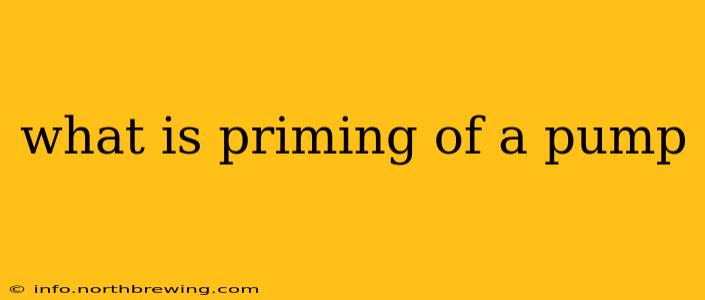Pump priming is a crucial process in ensuring the smooth and efficient operation of many types of pumps, especially those handling liquids that can cause cavitation or those that rely on suction lift. It involves filling the pump casing and suction pipe with liquid before starting the pump. This prevents the formation of vapor pockets or airlocks that can severely hinder or even damage the pump. Think of it like preparing the pump for its job – getting it ready to move liquid efficiently. This article explores the intricacies of pump priming, detailing its purpose, methods, and troubleshooting common issues.
Why is Priming Necessary?
Many pumps, particularly centrifugal pumps, rely on creating a vacuum to draw liquid into the pump casing. If there's air or vapor in the suction line, the pump won't be able to create the necessary vacuum, preventing liquid from entering. This leads to cavitation—the formation of vapor bubbles that collapse violently, causing noise, vibration, and potential damage to the pump impeller and internal components. Priming eliminates this air, ensuring the pump operates smoothly and prevents costly repairs.
Different Methods of Priming a Pump
Several methods exist for priming pumps, each suited to different pump types and applications:
1. Gravity Priming:
This is the simplest method, suitable for pumps located at a higher elevation than the liquid source. The pump and suction line are filled with liquid by simply opening valves and letting gravity do its work. This is often sufficient for smaller pumps and low-lift applications.
2. Manual Priming:
This involves manually filling the pump casing with liquid using a bucket or other container. This is a straightforward approach, frequently used for smaller pumps where gravity priming is not feasible.
3. Self-Priming Pumps:
These pumps incorporate a mechanism that automatically removes air from the suction line. They typically include an ejector or other device that creates a vacuum to draw liquid into the pump casing. These pumps require less maintenance concerning priming.
4. Vacuum Priming Systems:
These systems use an external vacuum pump to remove air from the suction line before starting the main pump. This is particularly useful for large pumps or those operating under difficult conditions.
How to Prime a Pump (General Steps)
The specific steps involved in priming a pump vary depending on the pump type and system design. However, the general process typically includes:
- Check Valves: Ensure all valves in the suction and discharge lines are correctly positioned.
- Fill the Pump: Manually or using gravity, fill the pump casing and suction line with liquid.
- Close Valves: Close any vent valves or air bleed valves.
- Start the Pump: Start the pump motor and monitor the operation.
- Check for Leaks: Inspect the pump and piping for any leaks.
Troubleshooting Priming Problems
Even with proper priming procedures, problems can still arise. Common issues include:
H2: What causes a pump to lose prime?
A pump can lose prime due to several factors, including leaks in the suction line, insufficient suction lift (the vertical distance the pump must draw liquid), air leaks into the system, a faulty foot valve (if used), or a clogged suction strainer. Regular inspection and maintenance of the pump and piping system are essential to prevent prime loss.
H2: How can I fix a pump that won't prime?
Troubleshooting a pump that won't prime involves systematically checking for the issues mentioned above. This includes inspecting for leaks, verifying the suction lift is within the pump's capabilities, checking the foot valve and strainer for clogs, and ensuring proper valve positioning. If the problem persists, professional assistance may be required.
H2: What are the signs of cavitation in a pump?
Cavitation manifests through various signs, including unusual noise (often described as a rattling or hammering sound), vibration, reduced pump performance (lower flow rate or head pressure), and even physical damage to the pump impeller.
H2: Why is my self-priming pump not working?
Even self-priming pumps can fail to prime if the suction lift is too high, there are leaks in the system, the pump is clogged, or there's a problem with the self-priming mechanism itself. Checking these elements can help diagnose and solve the problem.
This comprehensive overview provides a robust understanding of pump priming, addressing common questions and practical solutions for ensuring efficient pump operation. Remember that the specifics of priming depend on your pump type and system; consult your pump's manual for precise instructions.
